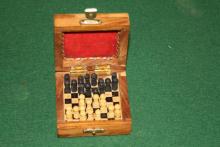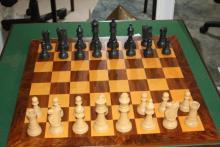Summary
There are useful opening 'rules' (really, guidelines) which should be known and adopted at least until you know better. Sadly, even strict obedience to the rules can lead to trouble, so you have to learn some specific opening lines. You don't have to know every opening, but you need at least one system for White and a couple as Black. Which ones you choose depends on your style and your appetite for study.Opening principles
It's useful to review and rehearse the reasons for the
'rules about
opening development', always remembering that there are
exceptions.
- Get your pieces out
into the
centre quickly. The opening is a
race to see who can get their pieces out first while
keeping at least
a share of control of the centre.
- This is the main point to remember; all the other
rules are
just
footnotes to this one. Sortez
les pieces!
- This is the main point to remember; all the other
rules are
just
footnotes to this one. Sortez
les pieces!
- Get a firm foothold in the centre - a pawn on one of the 'little centre' squares e4/e5/d5/d4 - and don't give it up without good reason
- Move your king to safety at the side by castling
- Complete your development before moving a piece twice or starting an attack. By move 12, you should have connected your Rooks, or be about to do so.
- More detail on winning the race:
- move pieces not pawns, and
- move them to their best squares in one move if you can, and also
- try to gain time if you can by aggressive moves.
- Move your minor pieces out early on generally move Knights before Bishops, and generally straightaway to f3/c3 or f6/c6 (but probably not both, as White)
- Don't move out your major pieces (Q+RR) where they will
get
chased around by the little guys and possibly trapped.
- Don't grab pawns or attack if you haven't completed developmen; especially, don't charge around with your Queen trying to hoover up pawns.
- If one side gets ahead in development:
- If you are ahead in development, start something going and open up lines for your better pieces
- If you are behind in development, don't start anything and keep things closed until you have caught up. This is especially true if you have not castled!
- Rooks are the hardest piece to develop: "openings should be judged on
the prospects
they offer to ambitious young Rooks" -
PURDY. To develop
your Rooks, open a file; to open a file, bring pawns into
a position to
swap them off; so after 1.e4, plan to play d2-d4 or f2-f4
soon.
- In fact, you have to attack the opponent's centre
with pawns
to get much chance of an advantage as White (The Four
Knights' Game is
next to Old Stodge in drawishness), so d2-d4 makes
sense for more than
one reason.
- In fact, you have to attack the opponent's centre
with pawns
to get much chance of an advantage as White (The Four
Knights' Game is
next to Old Stodge in drawishness), so d2-d4 makes
sense for more than
one reason.
Your ideal piece placement might look like this:
* Games illustrating these points
No.321
No.322
No.323
No.324
No.325
No.326
No.327
No.328
No.329
No.330
No.331
No.332
No.333
No.334
No.335
No.336
No.337
These are like little morality tales: greedy White grabs material
but courageous
Black wins in the end...
I leaned heavily for those notes on an excellent (although
long
out-of-print) book, How
to Open a
Chess Game, edited by Larry Evans, and with
chapters by leading
Grandmasters of the day (Larsen, Portisch, Petrosian,
Keres...).
Evans described the basic rules, then the remaining chapters
get
progressively more advanced, so it's a book you can put down
for a
while and pick up later and get more out of.
...Which should give
you another clue about rules having exceptions, (greedy White grabs material,
hangs on to
it and wins the endgame...) but you have to start
somewhere. [I often think about the first description
you give
pupils about an atom, like a little solar system with the
nucleus as a
sun that planets
(electrons) go around. I'm not sure I understand what
sort
of pictures physicists are working with these days, but I am
pretty
sure it's not very like the solar system.]
Coordination
This is a related issue. Just plonking your pieces on sensible squares will be OK for a long while, but as you get better you need to play moves that fit together, so that your pieces support not just each other but also at least one plausible short-term plan. Your opponent will be trying to achieve something in the position, and the least you can do is oppose their ideas, if not undertake something constructive yourself.
Lack of co-ordination is easy to identify.
I like to show this example:
* Ulvestad Variation 1.e4 e5
2.Nf3 Nc6 3.Bc4 Nf6 4.Ng5 d5 5.exd5 b5 6.Bxb5 Qxd5 ...
Now, White is far from lost here, but you get the idea I
hope.
Planless play can often lead to a position that looks OK
but is
going nowhere - that is oddly passive or has no potential to
expand.
* Nunn-Olafsson 1982 1.e4 e5 2.Bc4 Nf6 3.d3 Nc6 4.Nf3 Bc5 5.0-0 d6 6.c3 Qe7 7.Nbd2 a6 8.Bb3 0-0 9.Re1 Be6 10.Nf1 Ba7 11.Bc2 ...1-0 [GAME]
When your pieces are co-ordinated, ideas just flow.
* Steinitz-Tchigorin [GAME]
Co-ordination can trump development:
* Petrosian,T - Fischer,R (7) [A06] 1971 1.Nf3 c5 2.b3 d5 3.Bb2 f6 4.c4
d4 5.d3 e5
6.e3 Ne7 7.Be2 Nec6 ... 0-1 [GAME]
* Spassky,B - Karpov,A (10) [C95] 1974 1.e4 e5 2.Nf3 Nc6 3.Bb5 a6
4.Ba4 Nf6 5.0-0
Be7 6.Re1 b5 7.Bb3 d6 8.c3 0-0 9.h3 Nb8 10.d4 Nbd7 11.Nbd2
Bb7
... ½-½
General and particular
It's perfectly possible to follow the opening rules as laid
down
above, and still end up with a rotten position. Old
Stodge is an
example. General rules
have to be tested in particular positions, and in some
positions very
plausible moves that meet all the criteria we know can be
second-best,
if not actually bad. So after 1.e4 e5 2.Nf3 Nc6 3.d4
the 'right'
move is to give up your stake in the centre with 3...exd4,
as
everything else is pretty duff. In fact, Black cannot
be
prevented from playing ...d5 soon, but you have to know that
or work it
out. Hmm.
Here are some other lines where very sensible-looking play
can lead
to
trouble:
* Two Knights' Defence 1.e4 e5 2.Nf3 Nc6 3.Bc4 Nf6 4.Ng5 d5 5.exd5 Nxd5 All very sensible by Black 6.Nxf7!? That wasn't supposed to happen! (6.d4 may be even better)
* Ruy Lopez Steinitz Defence Tarrasch Trap 1.e4 e5 2.Nf3 Nc6 3.Bb5 d6 Black
plays
to hold e5 and develop quietly
4.d4 Bd7 5.Nc3 Nf6 6.0-0 Be7 7.Re1 0-0 [7...exd4
Black must
surrender the centre, which was not the idea of this
variation] 8.Bxc6 Bxc6
9.dxe5 dxe5 10.Qxd8 Raxd8
[10...Rfxd8 allows 15 Kf1 - see later] 11.Nxe5
Bxe4 [11...Nxe4 12.Nxc6]
12.Nxe4 Nxe4 13.Nd3 f5
14.f3 Bc5+
15.Nxc5 [15.Kf1? Bb6 16.fxe4 fxe4+] 15...Nxc5 16.Bg5 Rd5
[16...Rde8
17.Be7] 17.Be7 Re8 18.c4
1-0
Tarrasch-Marco 1892 [Tarrasch won this game AFTER publishing
it as
analysis!] [It's like a little course in tactics!]
* Modern Defence Averbakh Variation 1.d4 g6 2.c4 Bg7 3.e4 d6 4.Nc3 Nc6 5.Be3 e5 6.Nge2 exd4 7.Nxd4 Nge7 8.Be2 Impeccable development by White 8...f5 9.exf5 Bxd4! 10.Bxd4 Nxf5! 11.Be3 Nxe3 12.fxe3 Qg5 and Black is slightly better.
Unfair, perhaps, but real.
When this starts to happen, you need to get particular -
you need to
learn some proper opening variations and become aware of the
exceptions
in your chosen systems.
Putting together a repertoire
Most juniors when they start playing chess will play 1.e4 e5 and head
for the safe ground of Old Stodge.|
System for White |
System for Black |
|
| 1.e4 e5 |
Old Stodge |
Old
Stodge |
This is pretty terrible - no fun and no good for your
chess.
[Old Stodge is a Forbidden Opening at Exeter Junior Chess
Club.]
I
recommend playing something much livelier like
the Scotch Gambit or Italian Game as White and the Two
Knights' Defence
as Black.
|
System for White |
System for Black |
|
| 1.e4 e5 |
Italian Game |
Two
Knights' Defence |
Of course, if someone plays the Two Knights' Defence
against you,
you can't play the Italian Game.. As you get better, you
will meet
players who do not open 1.e4 as
White and do not reply to your 1.e4 with 1...e5. You
find you
need two opening systems (at least) as White and two as
Black.
You might even decide that you want to be one of those
players who do
not reply 1...e5 to 1.e4.
For example, I had a go at this some years ago, and have a
selection
of handouts online:
| White |
Black |
|
| 1.e4 e5 |
Italian
Game
[handout] |
|
| 1.e4 others |
Playing White against odd openings [handouts No.1 No.2] | Playing Black against odd openings after 1.e4 [handout] |
| 1.d4 d5 |
Playing Black against 1.d4 (and flank openings) [handout No.1 No.2 No.3] |
There are plenty
of
other
things on the site about other openings.
My latest efforts have been around sorting out something
simple
enough for juniors to absorb quickly, and I have changed my
mind a
little about what is most practical:
|
Systems for White |
Systems for Black |
|
| 1.e4 e5 |
A. Scotch
Gambit |
|
| 1.e4 others |
B.
IQP
systems |
C. French Defence |
| 1.d4 d5 |
D. Tarrasch Defence |
This set of opening systems I have written up as a Junior Repertoire booklet, available as a [PDF] or a [PGN] file.
After a while, you might decide this selection doesn't suit you completely. You might learn about the opening systems that the top Grandmasters choose, and discover that they include none of the ones you play! You might also want a deeper look at some of the openings you already know about. I have explored this in some other booklets:
|
A. Main system for White You need one of each! (at least) |
Your
style might
also be important. Like some Thai
restaurants, each menu item is labelled with a number
of chillies: # Steady Eddie |
Lastly,
you can (*) put your toe in the water, (**) have a deeper look or (*** and italics) make a real attempt at getting to grips with an opening system, even a GM one. |
I've been working on some booklets for youngsters which might be useful starting material, but I wouldn't describe them as much more than a fair draft at this stage. You can borrow what you like, but you have to give feedback!
|
Systems for White |
Systems for Black |
|
| 1.e4 e5 (A & C) |
ABCD Junior
Repertoire (Scotch
Gambit)
*
[PDF] ## A The Scotch Game * [PDF]
# A The Italian Game ** [PDF]
## A Danish Gambit *** [PDF]
### A The Ruy Lopez
(a GM
opening
explained) *** [PDF] # |
C Two Knights' Defence ** [PDF]
### C Playing Black against odd White openings after
1.e4 ** [PDF]
## |
| 1.e4 others (B & C) |
ABCD Junior
Repertoire (IQP
systems)
*
[PDF] ## B Playing White against odd Black defences after
1.e4 * [PDF]
## B Morra Gambit against the Sicilian *** [PDF] ### B TBD Tarrasch
Variation
against the French *** # B King's Indian Attack *** [PDF]
# |
ABCD Junior Repertoire (French Defence) * [PDF] C French
Defence
** [PGN] # C Sicilian
Defence (a GM
opening explained) *** [PDF]
## C (Sicilian Scheveningen) ***
[PDF] [PGN] ##
(done, but not in the
same style)
|
| 1.d4 d5 (A & D) |
A Colle System ** [PDF]
## A Queen's Gambit
(a GM
opening
explained) *** [PDF] [PGN] #
|
ABCD Junior
Repertoire (Tarrasch
Defence)
*
[PDF] ## D The Tarrasch Defence * [PDF]
## D The Tarrasch Defence for French Defence players
*** [PDF]
## D The Swiss Defence * [PDF]
# |
| 1.d4 others (B & D) |
B Playing White against odd Black defences after 1.d4 *** [PDF] [PGN] ## B Secret
Weapons
*** [PGN] ## |
D (Modern Benoni) *** [PDF]
### |
| Other (B & D) |
AB King's Indian Attack *** [PDF]
# |
ABCD Junior
Repertoire (Tarrasch
Defence)
*
[PDF] ## |
Pick a selection of four or so, including at least one each of ABCD, and stick with them for a year.
Comments and corrections welcome!





























































